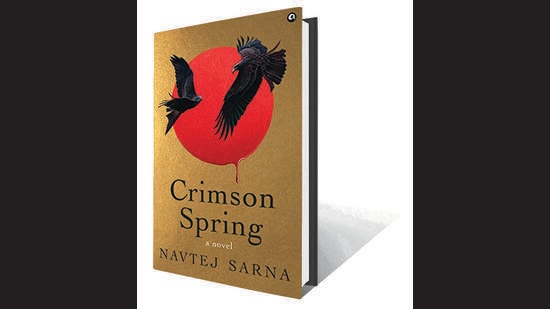Review: Crimson Spring by Navtej Sarna
Large events that make it to the history books often subsequently remain in public memory as stand-alone incidents. We remember the single act of the Jallianwala Bagh massacre but we know little of the whys and the hows that led to it. Inspired by real events and historical figures, Navtej Sarna’s Crimson Spring recreates a turning point in India’s history and is a detailed look at the cascading effects of a single event upon the peoples of both India and Britain.
Though a work of fiction, Sarna’s novel is meticulously accurate and grounds the massacre in the events that precede it — the Ghadar movement, the deportation of Dr Saifuddin Kitchlew and Dr Satyapal, the leaders of the protest movement against the Rowlatt Act (Kaala Kanoon), the return of the soldiers who fought for the British in World War 1, the patrols of the Danda Fauj, and the firing at non-violent hartals in Amritsar. It also presents the two men responsible for changing the history of a people, Reginald Dyer and Michael O’Dwyer, the Lt. Governor of Punjab. This is a much-needed preamble to the event itself and the reader gets glimpses into the playbook of the oppressors. The deportation of leaders to quell agitations, a repeat of 1907, and the comparison between Indian and Irish nationalists all serve as the tremors that precede the eruption. Sarna, the careful seismologist, measures and records each of them.
Through nine interwoven characters and lives, including Dyer, O’ Dwyer and Udham Singh, a timeline of events emerges. Others like Gurnam Singh Gambhir and Maya Dei keep a record of a way of life. They show the reader what Baisakhi in 1919 looked like — the celebration of the harvest, the cattle fair, the stalls of mithais, ornaments and sherbets, the rise and fall of the Mahants who had turned Sikh shrines into fiefdoms, and the Akali movement that was started to regain control of them, especially the Golden Temple. Sarna goes into tapestry-like detail when he describes the Amritsar of the period. Another one of his characters covers the plague sweeping through the interiors of Punjab and the attempts by the British to control its spread.
The devastation of a single incident is revealed using multiple characters from the same village, going their separate paths, to be reunited on that fateful day. The reader learns of the identities that were effaced and those that coalesced into a single mass of suffering, the multiple futures that were turned to ashes. All individuals are mourners now just as they were children in their shared childhood, helpless, together and yet alone. Sarna’s strokes of village life are so broad that the reader occasionally wishes there were a single diagram that kept track of the many characters and their complicated inter-relationships.
As for the massacre itself, Sarna presents the level of planning that went into it, which proves that it was not a spontaneous attack as was later claimed. The entry of Dyer into Amritsar is well documented, as is the subsequent army takeover of the city and its bridges. It is chilling to read about the surveillance of the area, the use of regiments most loyal to Dyer, his refusal to use British forces, and the repeated orders to fire.
What follows the massacre and what is perhaps less known is the colonial government’s attempt to break the soul of a people: the establishment of martial law, gallows in public places, quick trials, mass incarceration, the gunning down of civilians, torture, the flogging of children, citizens made to crawl on the road, and news blackouts. At this time, the Sewa Samiti, that countered the government narrative and set the record straight, is invaluable in the demand for justice. The final parts of the novel are, of course, devoted to Udham Singh and the great lengths to which the British system goes to keep him alive. He is force-fed and the buttons on his clothes are removed to prevent him from cheating the hangman’s noose.

What makes this a novel of great value is that it transcends the mere recording of an event. Instead, Sarna chronicles the history of a people, a way of life, the legacy of a city, and the culture that it embodies.
War photographer Robert Capa once said, “If your pictures aren’t good enough you are not close enough.” The joy of the historical fiction format is that it breaks the distance between the event and the reader. There is no lack of authenticity and spirit to be found in this work’s characters and pages. This is no distant cold look at what happened. Every part of Crimson Spring is alive and hauntingly close.
Percy Bharucha is a freelance writer and illustrator with two biweekly comics, The Adult Manual and Cats Over Coffee. Instagram: @percybharucha.
Large events that make it to the history books often subsequently remain in public memory as stand-alone incidents. We remember the single act of the Jallianwala Bagh massacre but we know little of the whys and the hows that led to it. Inspired by real events and historical figures, Navtej Sarna’s Crimson Spring recreates a turning point in India’s history and is a detailed look at the cascading effects of a single event upon the peoples of both India and Britain.
Though a work of fiction, Sarna’s novel is meticulously accurate and grounds the massacre in the events that precede it — the Ghadar movement, the deportation of Dr Saifuddin Kitchlew and Dr Satyapal, the leaders of the protest movement against the Rowlatt Act (Kaala Kanoon), the return of the soldiers who fought for the British in World War 1, the patrols of the Danda Fauj, and the firing at non-violent hartals in Amritsar. It also presents the two men responsible for changing the history of a people, Reginald Dyer and Michael O’Dwyer, the Lt. Governor of Punjab. This is a much-needed preamble to the event itself and the reader gets glimpses into the playbook of the oppressors. The deportation of leaders to quell agitations, a repeat of 1907, and the comparison between Indian and Irish nationalists all serve as the tremors that precede the eruption. Sarna, the careful seismologist, measures and records each of them.

Through nine interwoven characters and lives, including Dyer, O’ Dwyer and Udham Singh, a timeline of events emerges. Others like Gurnam Singh Gambhir and Maya Dei keep a record of a way of life. They show the reader what Baisakhi in 1919 looked like — the celebration of the harvest, the cattle fair, the stalls of mithais, ornaments and sherbets, the rise and fall of the Mahants who had turned Sikh shrines into fiefdoms, and the Akali movement that was started to regain control of them, especially the Golden Temple. Sarna goes into tapestry-like detail when he describes the Amritsar of the period. Another one of his characters covers the plague sweeping through the interiors of Punjab and the attempts by the British to control its spread.
The devastation of a single incident is revealed using multiple characters from the same village, going their separate paths, to be reunited on that fateful day. The reader learns of the identities that were effaced and those that coalesced into a single mass of suffering, the multiple futures that were turned to ashes. All individuals are mourners now just as they were children in their shared childhood, helpless, together and yet alone. Sarna’s strokes of village life are so broad that the reader occasionally wishes there were a single diagram that kept track of the many characters and their complicated inter-relationships.
As for the massacre itself, Sarna presents the level of planning that went into it, which proves that it was not a spontaneous attack as was later claimed. The entry of Dyer into Amritsar is well documented, as is the subsequent army takeover of the city and its bridges. It is chilling to read about the surveillance of the area, the use of regiments most loyal to Dyer, his refusal to use British forces, and the repeated orders to fire.
What follows the massacre and what is perhaps less known is the colonial government’s attempt to break the soul of a people: the establishment of martial law, gallows in public places, quick trials, mass incarceration, the gunning down of civilians, torture, the flogging of children, citizens made to crawl on the road, and news blackouts. At this time, the Sewa Samiti, that countered the government narrative and set the record straight, is invaluable in the demand for justice. The final parts of the novel are, of course, devoted to Udham Singh and the great lengths to which the British system goes to keep him alive. He is force-fed and the buttons on his clothes are removed to prevent him from cheating the hangman’s noose.

What makes this a novel of great value is that it transcends the mere recording of an event. Instead, Sarna chronicles the history of a people, a way of life, the legacy of a city, and the culture that it embodies.
War photographer Robert Capa once said, “If your pictures aren’t good enough you are not close enough.” The joy of the historical fiction format is that it breaks the distance between the event and the reader. There is no lack of authenticity and spirit to be found in this work’s characters and pages. This is no distant cold look at what happened. Every part of Crimson Spring is alive and hauntingly close.
Percy Bharucha is a freelance writer and illustrator with two biweekly comics, The Adult Manual and Cats Over Coffee. Instagram: @percybharucha.
